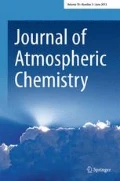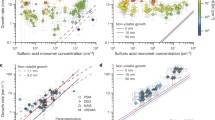Abstract
We present a theory for the formation of frozen aerosol particles in the Antarctic stratosphere, the coldest region of the Earth's stratosphere. The theory is applied specifically to the formation of polar stratospheric clouds. We suggest that the condensed ices are composed primarily of nitric acid and water with small admixtures of other compounds such as H2SO4 and HCl in solid solution. Our assumed particle formation mechanism is in agreement with the magnitude and seasonal behavior of the optical extinctions observed in the winter polar stratosphere. Physical chemistry and thermodynamic considerations suggest that at temperatures between about 200 and 185 K, stratospheric particulates are composed primarily of frozen nitric acid solutions with a composition near that of the trihydrate. Available data suggest the particles are amorphous solid solutions and not in the crystalline hydrate form. At lower temperatures (i.e., below the forst point of pure water) cirrus-like ice clouds can form.
Similar content being viewed by others
References
AtkinsR. W., 1978, Physical Chemistry, W. H. Freeman, San Francisco, p. 228.
J.-L.Clavelin and MirabelP., 1979, Determination des pressions partielles du mélange eau-acide nitrique, J. Chimie Physique 76, 533–537.
CrutzenP. J. and ArnoldF., 1986, Nitric acid cloud formation in the cold Antarctic strtosphere: A major cause for the springtime ‘ozone hole’, Nature 324, 651–655.
Ferry, G. V. and Lem, H. Y., 1974, Aerosols at 20 kilometers altitude, Preprints, 2nd International Conference on the Environmental Impact of Aerospace Operations in the High Atmosphere, San Diego CA, American Meteorological Society, pp. 27–33.
FarmanJ. C., GardnerB. G., and ShanklinJ. D., 1985, Large losses of total ozone in Antarctica reveal seasonal ClO x /No x interaction, Nature 315, 207–210.
FindlayAlexander, 1951, The Phase Rule and its Applications, Dover, New York, p. 224.
GableC. M., BetzH. F., and MaronS. H., 1950, Phase equilibria of the system sulfur trioxide-water, J. Amer. Chem. Soc. 72, 1445–1448.
HamillPatrick, 1975, The time dependent growth of H2O-H2SO4 aerosols by heteromolecular condensation, J. Aerosol. Sci. 6, 475–482.
HamillPatrick, ToonO. B., and TurcoR. P., 1986, Characteristics of polar stratospheric clouds during the formation of the antarctic ozone hole, Geophys. Res. Lett. 13, 1288–1291.
HuntenD. M., TurcoR. P., and ToonO. B., 1980, Smoke and dust part particles of meteoric origin on the mesosphere and stratosphere, J. Atmos. Sci. 37, 1342–1357.
HustonTheresa, HisatuneI. C., and HeicklenJulien, 1983, Low-temperature infrared studies of some acid-base reactions, Can. J. Chem. 61, 2077–2088.
KentG. S., PooleL. R., and McCormickM. P., 1986, Characteristics of arctic polar stratospheric clouds as measured by airborne lidar, J. Atmos. Sci. 43, 2149–2161.
KunzlerJ. E. and GiauqueW. F., 1952, The freezing point curves of concentrated aqueous sulfuric acid, J. Amer. Chem. Soc. 74, 5271–5274.
KusterF. W. and R.Kremann, 1904, Uber die Hydrate der saltpetersäure, Zeitschrift Anorg. Chemie 41, 1–42.
MasonB. J., 1971, The Physics of Clouds, 2nd edn., Oxford Univ. Press, London, p. 173.
McCormickM. P., SteeleH. M., HamillPatrick, ChuW. P., and SwisslerT. J., 1982, Polar stratospheric cloud sightings by SAM II, J. Atmos. Sci. 39, 1387–1397.
McElroyM. B., SalawitchR. J., WofsyS. C., and LoganJ. A., 1986a, Reduction of Antarctic ozone due to synergistic interactions of chlorine and bromine, Nature 321, 759–762.
McElroyM. B., SalawitchR. J., and WofsyS. C., 1986b, Antarctic O3: Chemical mechanisms for the spring decrease, Geophys. Res. Lett. 13, 1296–1299.
McGrawG. E., BernittD. L., and HisatuneI. C., 1965, Vibrational spectra of isotopic nitric acids, J. Chem. Phys. 42, 237–244.
PickeringS. U., 1893, Isolation of two predicted hydrates of nitric acid, J. Chem. Soc. 63, 436–443.
PruppacherH. R. and KlettJ. D., 1980, Microphysics of Clouds and Precipitation, D. Reidel, Dordrecht, pp. 102–103.
RosenJ. M., 1971, The boiling point of stratospheric aerosols, J. Appl. Meteor. 10, 1044–1046.
SolomonS., GarciaR. R., RowlandF. S., and WuebblesD. J., 1886, On the depletion of Antarctic ozone, Nature 321, 755–758.
SteeleH. M. and HamillPatrick, 1981, Effects of temperature and humidity on the growth and optical properties of sulphuric acid-water droplets in the stratosphere, J. Aerosol. Sci. 12, 517–528.
SteeleH. M., HamillPatrick, McCormickM. P., and SwisslerT. J., 1983, The formation of polar stratospheric clouds, J. Atmos. Sci. 40, 2055–2067.
StolarskiR. S., KreugerA. J., SchoeberlM. R., McPetersR. D., NewmanP. A., and AlpertJ. C., 1986, Nimbus 7 satellite measurements of the springtime Antarctic ozone decrease, Nature 322, 808–811.
ToonO. B., HamillPatrick, TurcoR. P., and PintoJoseph, 1986, Condensation of HNO3 in the winter polar stratosphere, Geophys. Res. Lett. 13, 1284–1287.
ToonO. B., TurcoR. P., HamillP., KiangC. S. and WhittenR. C., 1979, A one-dimensional model describing aerosol formation and evolution in the stratosphere: Part II. Sensitivity Studies and Comparisons with Observations, J. Atmos. Sci. 36, 718–736.
TurcoR. P., ToonO. B., WhittenR. C., HamillP., and KiangC. S., 1979, A one-dimensional model describing aerosol formation and evolution in the stratosphere: Part I. Physical processes and mathematical analogs, J. Atmos. Sci. 36, 699–717.
TurcoR. P., ToonO. B., HamillP., and WhittenR. C., 1981. Effects of meteoritic debris on stratospheric aerosols and gases J. Geophys. Res. 86, 1113–1128.
Wofsy, S. C., Molina, M., Salawitch, R. J., Fox, L. E., and McElroy, M. B., 1987, Interaction between HCl, NO x and H2O ice in the antarctic stratosphere: Implications for ozone. Preprint.
Author information
Authors and Affiliations
Rights and permissions
About this article
Cite this article
Hamill, P., Turco, R.P. & Toon, O.B. On the growth of nitric and sulfuric acid aerosol particles under stratospheric conditions. J Atmos Chem 7, 287–315 (1988). https://doi.org/10.1007/BF00130934
Received:
Revised:
Issue Date:
DOI: https://doi.org/10.1007/BF00130934



